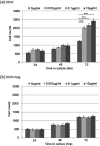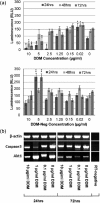Elucidating the cellular actions of demineralised dentine matrix extract on a clonal dental pulp stem cell population in orchestrating dental tissue repair
- PMID: 26019808
- PMCID: PMC4437905
- DOI: 10.1177/2041731415586318
Elucidating the cellular actions of demineralised dentine matrix extract on a clonal dental pulp stem cell population in orchestrating dental tissue repair
Abstract
Bioactive growth factors identified within the extracellular matrix of dentine have been proposed roles in regulating the naturally inherent regenerative dentine formation seen in teeth in response to trauma and infection, which may also be harnessed for novel clinical treatments in augmenting mineralised tissue repair. This study examined the specific biological action of demineralised dentine matrix extract on a clonal population of dental pulp stem cells in stimulating the prerequisite stages of wound healing associated with mineralised tissue repair. A clonal dental pulp stem cell population with sustained proliferative capacity and multi-potentiality towards osteogenic, adipogenic and chondrogenic lineages was isolated from the pulp of human third molars. Dentine was collected from human healthy teeth, powdered and treated with ethylenediaminetetraacetic acid to obtain a solubilised DDM protein extract. The influence of DDM on the DPSC clonal population was assessed in vitro. Exposure of cells to proteolytically degraded DDM or unsupplemented media served as controls. Compared to controls, DDM stimulated cell expansion, reduced apoptotic marker caspase 3, increased cell survival marker Akt1 and enhanced mineralised matrix deposition as determined by mineral deposition and increased expression of bone-related markers, alkaline phosphatase and osteopontin. Dental pulp stem cells successfully migrated into collagen gels supplemented with demineralised dentine matrix, with cells remaining viable and expanding in numbers over a 3-day period. Collectively, the results provide evidence that soluble proteins extracted from dentine matrix are able to exert a direct biological effect on dental pulp stem cells in promoting mineralised tissue repair mechanisms.
Keywords: Dental pulp; anti-apoptotic; cell proliferation; dentine matrix; dentine repair; mesenchymal stem cells; odontogenesis; osteogenesis.
Conflict of interest statement
Figures





References
-
- Smith AJ, Sloan AJ. Stem cells and the dental pulp: potential roles in dentine regeneration and repair. Oral Dis 2007; 13: 151–157. - PubMed
-
- Park ES, Cho HS, Kwon TG, et al. Proteomics analysis of human dentin reveals distinct protein expression profiles. J Proteome Res 2009; 8: 1338–1346. - PubMed
-
- Chun SY, Lee HJ, Choi YA, et al. Analysis of the soluble human tooth proteome and its ability to induce dentin/tooth regeneration. Tissue Eng Part A 2011; 17: 181–191. - PubMed
-
- Jágr M, Eckhardt A, Pataridis S, et al. Comprehensive proteomic analysis of human dentin. Eur J Oral Sci 2012; 120: 259–268. - PubMed
-
- Sloan AJ, Perry H, Matthews JB, et al. Transforming growth factor-b expression in mature human molar teeth. Histochem J 2000; 32: 247–252. - PubMed
Grants and funding
LinkOut - more resources
Full Text Sources
Other Literature Sources
Research Materials
Miscellaneous

